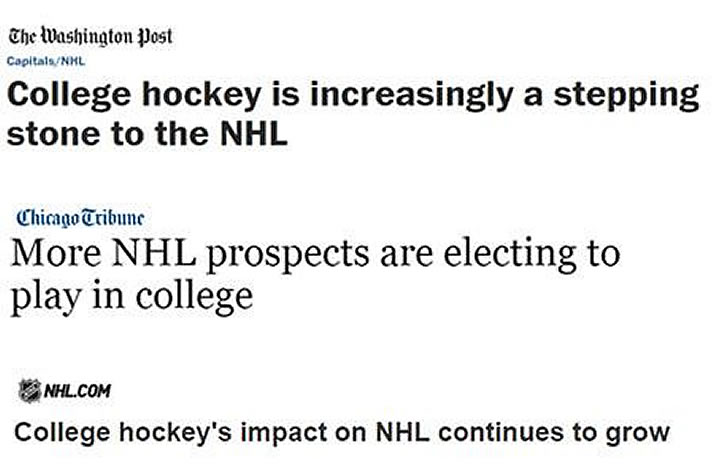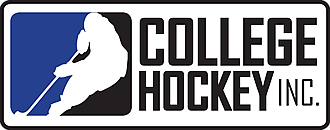Friday, June 26, 2015
Media Sings NCAA’s Praises
Growing influence in the NHL a hot topic in Washington Post, Chicago Tribune and NHL.com.

As the NHL prepared to select another group of future stars in Friday’s NHL Draft, a number of media outlets took note of the growing impact former NCAA hockey players are having in the league.
The Washington Post, Chicago Tribune and NHL.com all published stories on college hockey’s increased influence as Jack Eichel, Noah Hanifin and Zach Werenski stood poised to become the first three current NCAA players to be taken in the top 10 of one NHL Draft.
Each story took a different approach to covering the growing trend, which has seen the percentage of NCAA alums in the NHL jump from 20% 15 years ago to 30% in 2014-15.
Some highlights:
New Jersey Devils forward Mike Cammalleri, who played three seasons at the University of Michigan, isn’t surprised by the fact that 30 percent of NHL players developed in the NCAA, or that all 30 NHL teams had at least one prospect enrolled in college during the 2014-15 season, with the Stanley Cup champion Chicago Blackhawks’ 13 leading the way.
“College hockey not only allows for a readiness on the ice in terms of skill, but there’s a social and outside-the-classroom aspect to developing a personality and comfort within your own skin enabling players to enter the NHL and be successful,” Cammalleri said. “I think that’s an important development stage for an adolescent person regardless of athletics and why some players are able to come in and do well out of college.”
– Mike Morreale, NHL.com
Many American-born NHL picks opt for major junior. But an increasing number are electing to stick with school, where a scholarship can be far more valuable than a stipend. Three of the top 10 draft prospects listed in this year’s NHL Central Scouting midterm rankings are from the NCAA. ,
“It really has changed in the last seven, eight years,” Michael Finewax, a hockey draft analyst for Rotoworld.com, said. “NHL teams like guys who go to college. It doesn’t take any cost to develop them, and they get to see them develop for much longer. It’s much easier to take a chance on a 22-year-old than an 18-year-old.”
– Steven Goldstein, Chicago Tribune
In this regard, Eichel, Hanifin and Werenski are anomalies, highly recruited phenoms each ranked among the five youngest players in Division I this season. (All five were 17 when the season began on Oct. 1, compared to the average freshman age of 20.2.) And perhaps location dictated their path, too; each chose a renowned program in his home state, while projected 2016 No. 1 pick Auston Matthews, an Arizona native, is reportedly choosing between the Canadian junior route or playing overseas.
Still, their mere presence in Florida represents a growing trend. In 2002-03, former NCAA players comprised 21 percent of NHL rosters. Last season, according to data from College Hockey Inc., that rate reached 30 percent.
“I think it helps them be prepared on the mental side of the game and the physical side, because they’re more mature to handle trying to compete for an NHL roster position,” said Dan Marr, Director of NHL Central Scouting. “The elite 18 and 19 years old, and I mean elite, where there’s three or four a year, they can handle it because they have the talent and the abilities, but there’s too many others who fall through the cracks because they aren’t really prepared, and sometimes their careers are short-lived. I think that the players that have a little more patience, I’m not surprised that it’s showing or tracking that once these players get into the league, they stay there.”
– Alex Prewitt, Washington Post
